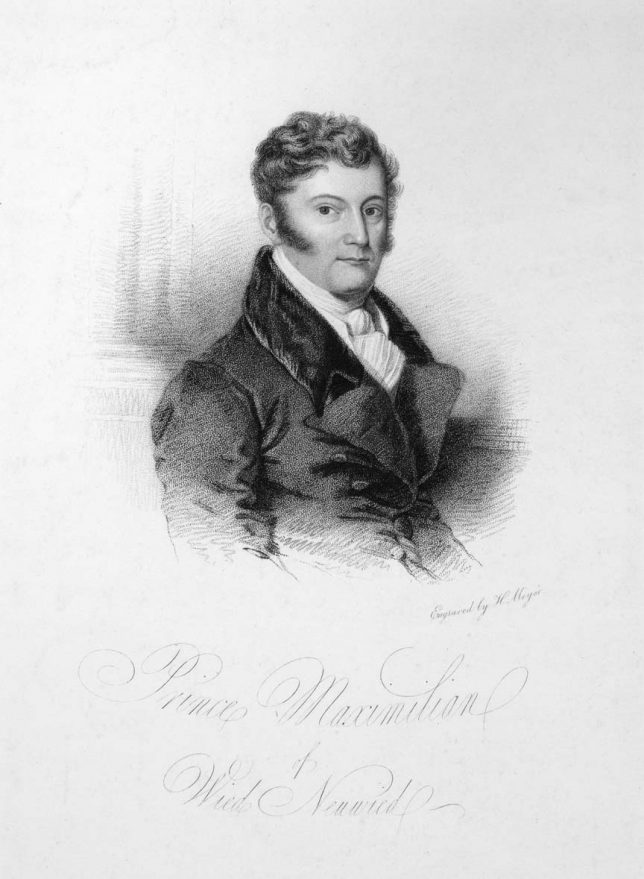
Prince Maximilian Alexander Philipp of Wied was a German explorer and naturalist who traveled through Brazil in 1815-17 and through the United States in 1832-34. He became best known for his studies of the Northern Plains tribes in the United States, especially the Mandans and Hidatsas.
Prince Maximilian was born the eighth of eleven children1 on September 23, 1782, in the city of Neuwied, Germany. His parents were Friedrich Carl Count of Wied-Neuwied (1741-1809) and Louise Wilhelmine Countess of Sayn-Wittgenstein-Berleburg (1747-1823). The most influential people in Maximilian’s career were Johann Friedrich Blumenbach, the Enlightenment’s leading theorist on comparative anthropology, and Alexander von Humboldt, who became his mentor and friend after they met in Paris in 1814.2
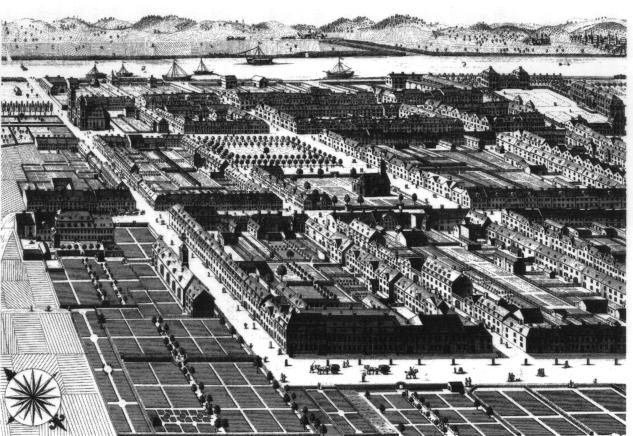
Whenever the Prince was free of military service in the Prussian army, he diligently pursued his scientific studies. He learned his skills as a naturalist mainly on his own, but he also enrolled at the University of Göttingen in 1811-12 to study under Blumenbach. In 1815, encouraged by Humboldt, the Prince led his first major expedition to Brazil, where he studied the flora and fauna of the Mata Atlantica and indigenous peoples such as the Botocudo, Puri, and Pataxo. Upon returning to Germany in 1817, Maximilian devoted himself to the analysis of his Brazilian experience, which culminated in the two-volume “Journey to Brazil in the Years 1815-17” (1820-21).
In the late 1820s, Maximilian began preparations for a second major expedition. Originally he played with the idea of exploring Labrador or the Kirgisian Steppe in Russia, but by 1830 he had decided to travel to North America. One stated purpose of this journey was to continue his investigation of the flora and fauna of the Americas, but he also intended to study the indigenous cultures of North America and compare them with those of southeastern Brazil. In May of 1832 Maximilian, accompanied by the Swiss painter Karl Bodmer, left Europe for the United States, where they arrived in early July. After a tour of eastern, cities they traveled west. Because of a serious illness resembling cholera, Maximilian was forced to stay the winter of 1832-33 in New Harmony, Indiana, where he enjoyed the company of fellow naturalists Thomas Say and Charles Alexandre Lesueur.
In the spring of 1833 Maximilian finally arrived in St. Louis, where he made arrangements to travel up the Missouri with boats belonging to the American Fur Company. After short stops in Forts Pierre, Clark, and Union, the Prince arrived at Fort McKenzie, the westernmost point of his expedition, in August of 1833. Originally Maximilian wanted to extend his studies farther upriver into the Rocky Mountains, but the hostility of the three Blackfeet tribes forced him to reconsider this plan. After about five weeks of fieldwork around Fort McKenzie, the Prince returned to Fort Clark to stay for the winter of 1833-34. There he devoted his time to a thorough study of the Mandans and Hidatsas and to a less complete analysis of the nearby Arikaras.
In his travel accounts Maximilian routinely described the physical appearance of the indigenous peoples he encountered, then concentrated on recording their customs, language, and culture, including one of the most important ceremonies of the Mandans, the O-kee-pa. Maximilian’s visit to the upper Missouri came at a time when the fur trade increasingly altered the social, political, and cultural characteristics of the Northern Plains tribes, and he recorded many of these changes, even though he was not always aware of their significance. His travel writings also reinforced the Romantic interest in the noble savage, an invented image which had fascinated intellectuals throughout Europe since the late Renaissance.
In April of 1834 the Prince journeyed back to the East Coast, then on to Europe in July. As soon as he returned to Neuwied, Maximilian began the synthesis of his expedition, which culminated in the publication of the two-volume “Travels in the Interior of North America” (1839-41). In the years following, and until a few years before his death on February 3, 1867, in Neuwied, he continued to publish articles on his American experience. Maximilian’s legacy survives in the nomenclature of plants and animals in both North and South America (for example, the “Maximilian sunflower” Helianthus maximilianii, the orchid Maxillaria neuwiedii, the Cretaceous saurian Mosasaurus maximiliani, birds such as “Maximilian’s Parrot” (Pionus maximiliani), reptiles such as “Maximilian’s Snake-Necked Turtle” (Hydromedusa maximilianii), and mammals such as the margay (Felis Wiedii)).
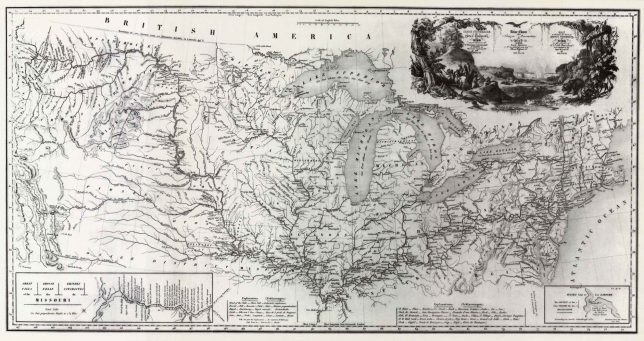
1 The common understanding is that Prince Maximilian was the eighth of ten children. However, based on documents found at the archives of abbey Rommersdorf (near Neuwied) he had an “unnamed brother” who was stillborn on April 24, 1786.
2 Considerable discussion exists as to when Prince Maximilian met Alexander von Humboldt for the first time, and the year 1804 is commonly mentioned. However, in a letter Prince Maximilian wrote to the Swiss naturalist Rudolf Schinz on May 28, 1814, he stated that “… Humboldt and Bonpland now also belong to the number of my acquaintances.”
“Ein Prinz Unter Indianern: Die Reisen des Prinz Maximilian zu Wied“
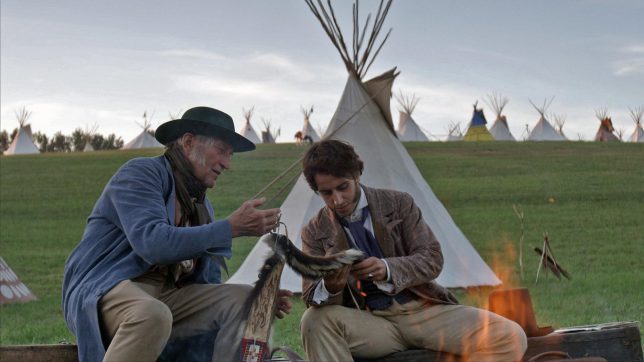
I had the honor and pleasure to contribute to this production.
Further information on Prince Maximilian of Wied:
Noll, Michael G., “Prince Maximilian’s Other Worlds.” The Pennsylvania Geographer, 43 (2005): 65-83.
Noll, Michael G., Prince Maximilian’s America: The Narrated Landscapes of a German Explorer and Naturalist (Dissertation, University of Kansas, Copyright 2000)
Roth, Hermann Josef (ed.), “Maximilian Prinz zu Wied: Jaeger, Reisender, Naturforscher”, Fauna und Flora in Rheinland-Pfalz, Beiheft 17 (Landau: Gesellschaft fuer Naturschutz und Ornithologie Rheinland-Pfalz e.V., 1995).
Schach, Paul, “Maximilian, Prince of Wied (1782-1867): Reconsidered.” Great Plains Quarterly 14 (1994): 5-20.
Wied, Maximilian Prinz zu, Reise in das Innere Nord-America in den Jahren 1832 bis 1834, 2 volumes (Coblenz: Hoelscher, 1839-41).
Witte, Stephen S. and Marsha V. Gallagher, eds. The North American Journals of Prince Maximilian of Wied, volumes 1-3 (Norman: University of Oklahoma Press, 2008, 2010, 2012)
(Click here for more information about Prinz Maximilian zu Wied in German.)
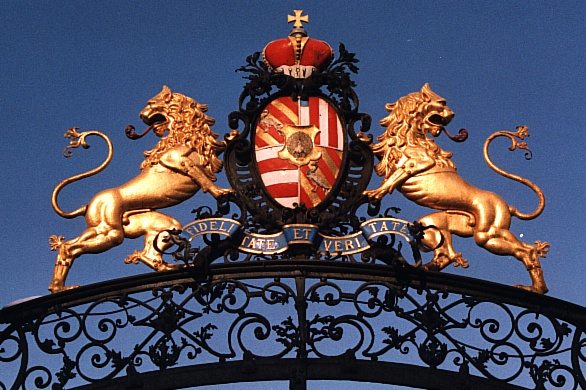

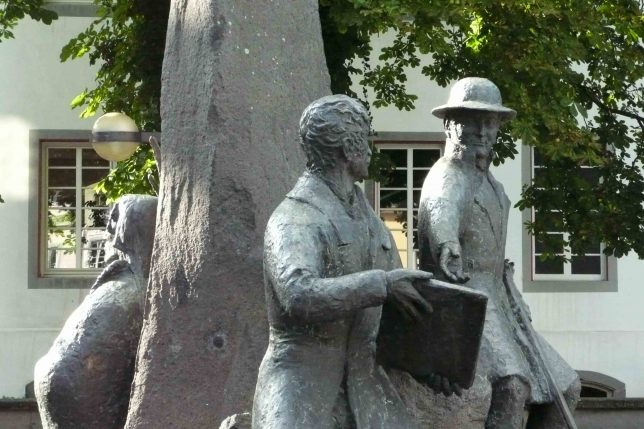
(Sculpture by Guta von Freydorf-Stephanow, 1987).
Maximilian is carrying a rifle, while Karl Bodmer is holding a sketch book. Also on this photograph and facing west is the Mandan chief Mató-Tópe.

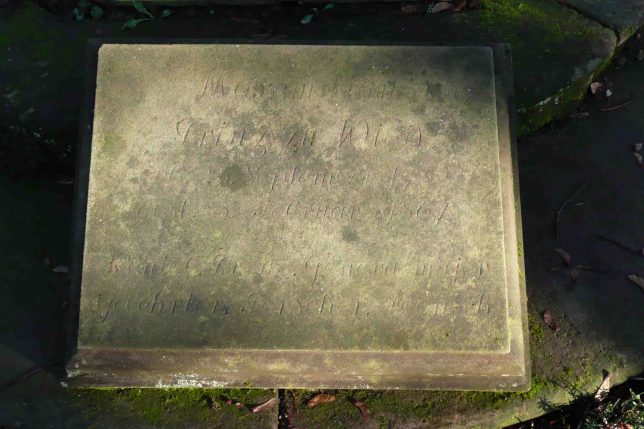
Until the 1870s members of the Wied family were buried there. Later the family used their private cemetery near the castle of Monrepos for burials. The image to the left shows the grave marker for Johann Friedrich Alexander zu Wied, the first reigning Prince of Wied from 1784 until 1791. The image to the right shows the marker for Maximilian’s grave, now propped up against the monument of his ancestor. The exact location of Maximilian’s grave is uncertain. Inscribed on the plate are the words “Maximilian, Prinz zu Wied, geb. 23. September 1782, gest. 3. Februar 1867, Koenigl. Preuβ. General Major, Gelehrter, Forscher u. Mensch”.